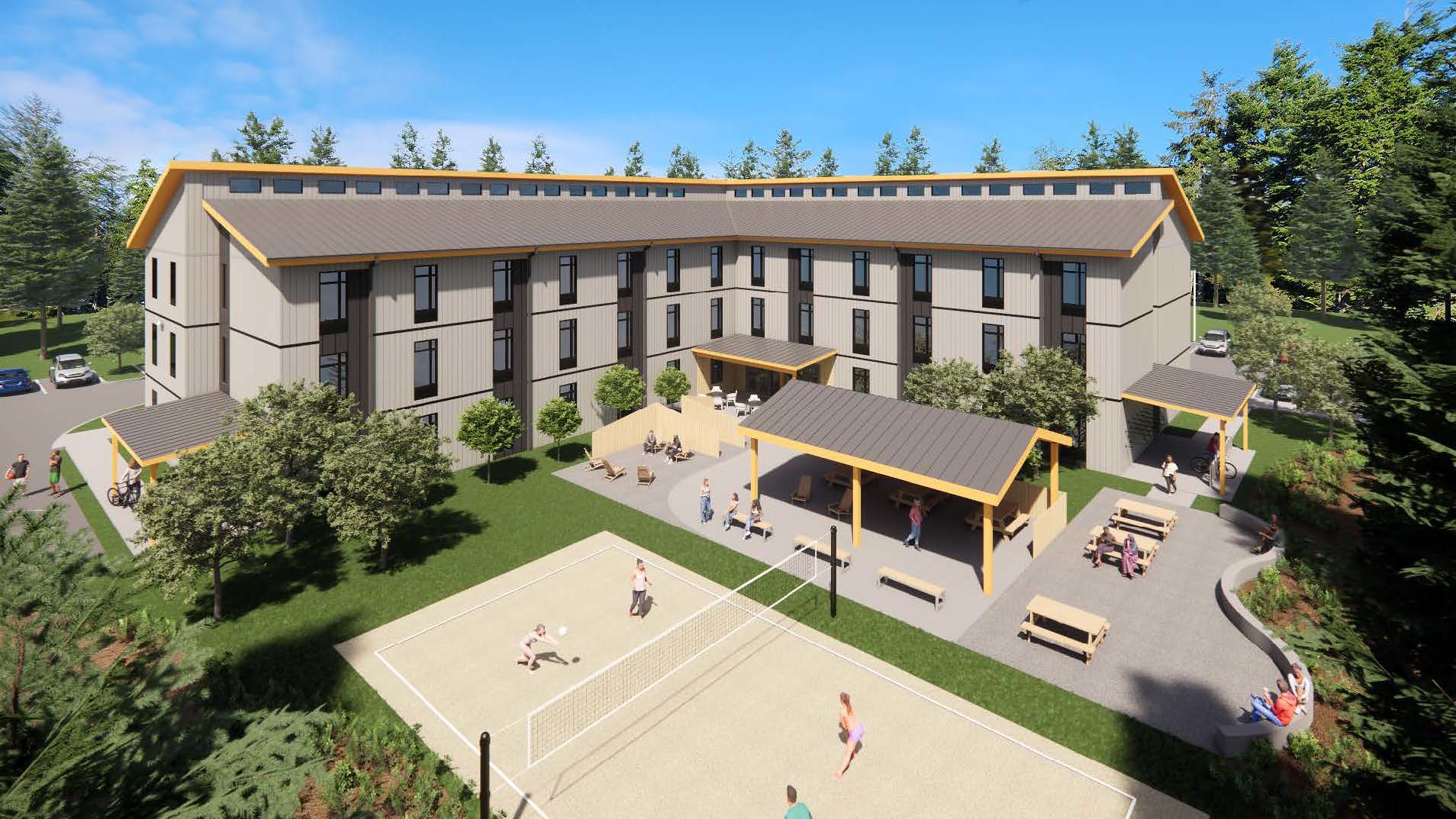
By REBECCA HANSEN-WHITE/KLCC News
Over the last 20 years, Marti Johnson has lived in a few small Oregon Coast towns, but she’s always considered Newport home.
“Coming up here, especially the sign that Newport has that (says) ‘the friendliest?’” she said. “I’ve never met more friendly people in my life.”
Johnson said her teenage son has been in the same school system his entire life, an experience she never had growing up. He’s had opportunities to play sports and be surrounded by a circle of family and friends.
Johnson is an emergency medical technician and first aid instructor. She said despite working more and spending less, it gets harder for her family to stay housed every year.
“We’ve been so close so many times,” she said. “I’ve had to borrow money from family members I still owe, I’ve had to sell things that were family heirlooms (such as) my grandpa’s coin collection that he passed down to me. Things I didn’t want to do, I’ve done, to just try and make sure that we had another month.”
Johnson said in the past she’s had to scramble to find housing after previous landlords sold the home she was living in, or raised the rent higher than she could pay.
“Working 40 hours, picking up every extra shift, working overtime, it still doesn’t cut it,” she said. “The struggle is real.”
She said if that happens again, her family may end up on a friend’s couch, or be forced to leave the Oregon Coast altogether.
While tourism has rebounded since the pandemic, many Oregon Coast residents are still struggling with housing instability and homelessness.
According to the Lincoln County School District, roughly 15 percent of its students are experiencing severe housing instability or homelessness. That’s almost four times higher than the state average for school districts.

Karen Rockwell, the executive director of the Housing Authority of Lincoln County, said housing instability is rapidly becoming the norm for many on the Oregon Coast — including teachers, healthcare and service workers.
“They are unable to find decent places to live at all, and there are no subsidies for them,” she said.
Some employers, like the city of Newport and Samaritan Health Serrvices, have rented apartments for new workers while they search for housing. Others, like Oregon State University, have resorted to building their own accommodations for students and researchers at the Hatfield Marine Science Center.

A housing bottleneck
Those who work for smaller employers are often on their own to find a place to live, often choosing between a long commute or the handful of rentals in their price range.
Rockwell said the shortage of workforce and affordable housing has had a cascading effect that’s made it very challenging to respond to homelessness, addiction or mental illness.
She said most housing organizations hope to move people along the housing continuum: from the street into subsidized housing, and then market rate housing once they are stabilized. Rockwell said the Oregon Coast’s housing ladder is bottlenecked.
“In our situation, because our vacancy rates are so low and our housing accessibility is so limited,” she said, “we really don’t have the ability for people to move out of subsidized housing into market rate housing because there isn’t enough market rate housing to begin with.”
Rockwell said the wait list for a subsidized apartment in Lincoln County is two years — despite several new affordable housing projects opening recently.
The wait list for those who opt for a housing voucher instead of renting directly from the housing authority is significantly shorter, but only 50 percent of recipients find a place to live before it expires.

Freddy Saxton, a long-time Newport-area real estate agent and former homebuilder, said construction in the area has always been a little more expensive than other communities, in part because there’s a limited supply of buildable land.
“Most vacant lands that are in city limits nowadays are steep, maybe not the best geology,” he said. “Maybe they’re in the tsunami zone, (or on the) side of a hill. It’s just a whole lot more expensive to develop those types of properties as opposed to, say, a nice flat piece of dirt.”
Saxton said there’s also been an increase in non-local buyers looking for a retirement or second home.
“A portion of our business is locals who are maybe selling, or maybe moving out of the area,” he said. “I would say about two-thirds of the buyers we encounter are coming from other areas, whether it’s Portland or the Bay Area or other states. There is quite an influx coming into this community, probably more so than others.”
‘Buying down the cost’
Lincoln County, as well as several other governments across the Oregon coast, has tried other policies in hopes of making more housing available for their employees and residents, including regulating vacation rentals.

But the city of Newport’s planning and community development director Derrick Tokos said surprisingly, vacation rentals often aren’t the most significant factor impacting housing supply.
He said about 15 percent of the city’s total housing is seasonal — which means it’s vacant during the winter. He said the bulk of that is second homes, not vacation rentals, an issue the city doesn’t have much authority to regulate.
“Short-term rentals are an easy scapegoat for frustrations that really are larger than that,” he said.
Tokos said local governments need more options to address the housing shortage, such as being allowed to spend more hotel room taxes on affordable housing, instead of tourism promotion, or being able to collect taxes on real estate transactions.
“Work needs to be done to come up with real, meaningful funding mechanisms,” he said.

Lincoln County commissioner Kaety Jacobson said local governments have been trying to address the shortage — winning millions in grants for new affordable housing projects.
But she said many workers are at risk of becoming homeless because they make too much money to qualify for most types of assistance.
“You have to buy down the cost of building,” she said, “but there’s no fund to really do that. So that has been a state and federal policy issue we’ve struggled with because we need to build workforce housing, it needs to be subsidized, but there’s really no clear path to that subsidy.”
Lincoln County commissioner Claire Hall said the symptoms of increasing disparity on the Oregon coast, workforce shortage and visible homelessness, has prompted some who might have resisted dense, or affordable housing, to reconsider.
“It has finally reached a tipping point that people who couldn’t see the problem, or didn’t want to see the problem, are now directly confronted with the problem,” Hall said.
- Rebecca Hansen-White joined KLCC News in 2023. Her journalism career has included stops at Spokane Public Radio, The Spokesman-Review, and The Columbia Basin Herald.



The housing problem is everywhere not just on the coast. Jobs are much harder to find here and people coming here seem to think rent will be less and jobs are abundant. Living at the coast you will work for less than you can make in a bigger city. The cost of living has increased tremendously everywhere. My taxes have increased my garbage, my electricity, my garbage bill has been raised 3 times. My pay has not kept up with the inflation that is for certain. I had hoped to retire and not have to work, but I need to work at least part time to pay my bills. I had rentals prior, never again. How many people used the covid money to pay their rent?? Hardly any, and those people that had rentals didn’t get a break from their mortgage company. Many places say they need help and have signs out “hiring” but I see different people all the time and these places. I have had to work my entire life, I don’t know how people make it if they don’t work. I am 69. Our housing problems is our economy not vacation rentals, we need those and people should be able to keep their vacation rentals in my opinion. No matter what is built, those people renting need to get a job and work. I am not a believer of everything is free or should be free. The last four years have been much worse than the 4 years prior for me.
“As economy rebounds, many Lincoln County residents still struggle to find adequate housing”.
The title of this article, I feel, is misleading. The economy is not rebounding. Ask anyone at the Oregon Coast or statewide. Everyone is struggling. It is obvious that the economy is not rebounding in any way, shape or form for anyone, especially in the lower 90% of our population.
How is it obvious that the economy is not rebounding? Employment is at record highs, the stock market is at record highs, inflation has been brought below 3%, U.S. energy production is higher than ever, household wealth is surging, wages are rising faster than costs and people who claim were better off than 4 years ago seem to forget the fact there was a pandemic and the economy was in a horrible place 4 years ago. Yes, we had a bad bout of inflation and prices are higher. But I remember when gas was 20 cents a gallon and a loaf of bread was a quarter. All this bellyaching about the economy is simply part of a dystopian vision of America and not reality.